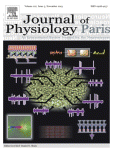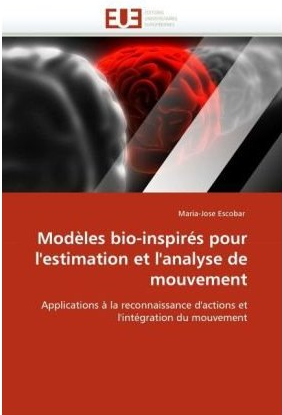Publications
2022
- Escobar M.J., Navarro-Guerrero N., Ruiz-del-Solar J., Sandini G. (2022) Special Issue on Emerging Topics on Development and Learning. IEEE Transactions on Cognitive and Developmental Systems, vol. 14, issue 2, pp. 255-257 (link)
DOI: 10.1109/TCDS.2022.3165964 - Otero M., Lea-Carnall C., Prado P., Escobar M.J., El-Deredy W. (2022) Modelling neural entrainment and its persistence: influence of frequency of stimulation and phase at the stimulus offset. Biomedical Physics and Engineering Express (link)
DOI: 10.1088/2057-1976/ac605a
2021
- Araya J., Bello F., Shivashankar G., Neira D., Durán-Aniotz C., Acosta M., Escobar M.J., Hetz C., Chacón M., Palacios, A.G. (2021) Retinal Ganglion Cells Functional Changes in a Mouse Model of Alzheimer's Disease Are Linked with Neurotransmitter Alterations. Journal of Alzheimer's Disease, vol. 82, no. s1, pp. S5-S18 (link).
DOI: 10.3233/JAD-201195 - Herzog R., Morales A., Mora S., Araya J., Escobar M.J., Palacios A.G., Cofre R. (2021) Scalable and accurate method for neuronal ensemble detection in spiking neural networks. Plos ONE, 16(7):e0251647 (link).
DOI: 10.1371/journal.pone.0251647 - Torres F., Otrio P., Escobar M.J. (2021) Selection of stimulus parameters for enhancing slow wave sleep events with a Neural-field theory thalamocortical model. PLoS Comput Biol 17(7): e1008758 (link).
DOI: 10.1371/journal.pcbi.1008758
2020
- Otero M., Prado P., Weinstein A., Escobar M.J., El-Deredy W. (2020)
Persistence of EEG alpha entrainment depends on stimulus phase at offset.
Frontiers in Human Neuroscience, Vol. 14, pp 139 (link).
DOI: 10.3389/fnhum.2020.00139 - Mucarquer J.A., Prado P., Escobar M.J., El-Deredy W., Zanartu M. (2020).
Improving EEG muscle artifact removal with an EMG array.
IEEE Transactions on Instrumentation and Measurement, Vol. 69, No. 3, pp 815-824 (link).
DOI: 10.1109/TIM.2019.2906967 - Lehnert H., Araya M., Carrasco-Davis R., Escobar M.J. (2020).
Bio-Inspired Deep Reinforcement Learning for Autonomous Navigation of Artificial Agents.
IEEE Latin America Transactions, Vol. 18, No. 12, pp 2028-2035 (link).
DOI: 10.1109/TLA.2019.9011549
2019
- Reyes P., Escobar M.J.. (2019) NeuroEvolutive Algorithms for Learning Gaits in Legged Robots. IEEE Access, Vol. 7, pp 142406 - 142420. (link, PDF).
DOI: 10.1109/ACCESS.2019.2944545 - Inteligencia Artificial para Chile: La Urgencia de Desarrollar una Estrategia. Comisión "Desafíos del Futuro, Ciencia, Tecnologia e Innovación", 2019, (pdf)
- Prado-Gutiérrez P., Otero M., Martínez-Montes E., Weinstein A., Escobar M.J., El-Deredy W.,
Zanartu M. (2019).
A Method for Tracking the Time Evolution of Steady-State Responses.
JoVE - Journal of Visualized Experiments, e59898. (link)
DOI: 10.3791/59898 - Lenhert H., Araya M., Escobar M.J. (2019).
Retina-inspired Visual Module for Robot Navigation in Complex Environments.
2019 International Joint Conference on Neural Networks (IJCNN), Budapest, Hungry, 2019, pp. 1-8
Oral Presentation, (link).
DOI: 10.1109/IJCNN.2019.8851896 - Escobar M.J., Guerrero R. (2019). El Estereotipo Erróneo a lo Largo del Desarrollo Educacional y Laboral de la Mujer en STEM. In: Género y Universidad, una pregunta abierta. Editorial USM, Enero 2019, ISBN: 978-956-356-066-4 (PDF).
- Ravello C.R., Perrinet L.U., Escobar M.J., Palacios A.G. (2019).
Speed-Selectivity in Retinal Ganglion Cells is Sharpened by Broad Spatial Frequency, Naturalistic Stimuli.
Scientific Reports 9, 456 (link)
DOI: 10.1038/s41598-018-36861-8
2018
- Escobar M.J., Otero M., Reyes C., Herzog R., Araya J., Ibaceta C.,
Palacios A.G. (2018). Characterization of Retinal Functionality at different Eccentricities in a Diurnal Rodent.
Frontiers in Cellular Neuroscience, Volume 12, pp 444 (link).
DOI: 10.3389/fncel.2018.00444 - Herzog R., Escobar M.J., Cofre R., Palacios A.G., Cessac B. (2018)
Dimensionality Reduction on Spatio-Temporal Maximum Entropy Models of Spiking Networks.
biorXiv: 278606 (link).
DOI: 10.1101/278606. - Benzi M., Escobar M.J., Kornprobst P. (2018).
A bio-inspired synergistic Virtual Retina model for tone mapping.
Computer Vision and Image Understanding, Volume 168, pp 21-36 (link),
(article webpage). Inria Research Report 9033
(link).
DOI: 10.1016/j.cviu.2017.11.013. - Escobar M.J., Otero M., Reyes C., Herzog R., Araya J., Ibaceta C.,
Palacios A.G. (2018).
Functional Asymmetries between Central and Peripheral Retinal Ganglion Cells in a Diurnal Rodent.
biorXiv: 277814 (link).
DOI: 10.1101/277814. - Nettle C., Rubilar F., Escobar M.J. (2018).
Coupling Robots Behavior by Introducing Reactive Motivational Orientations.
2018 International Joint Conference on Neural Networks (IJCNN), Rio de Janeiro, 2018, pp. 1-8.
Oral Presentation, (link).
DOI: 10.1109/IJCNN.2018.8489253
2017
- Palacios A.G, Escobar M.J., Céspedes E. (2017). Missing colors: an enactivist approach to perception. Constructivist Foundations, Volume 13, Number 1, pp 117-125 (link)
- Palacios A.G, Escobar M.J., Céspedes E. (2017). Authors' Response: Is a Weak Notion of Representation not Compatible with a Contextualist and Enactivist Account of Perception?. Constructivist Foundations, Volume 13, Number 1, pp 135-140 (link)
- Silva O., Sigel P. and Escobar M.J. (2017).
Time Delays in a HyperNEAT Network to Improve Gait Learning for Legged Robots.
30th International Joint Conference in Neural Networks (IJCNN2017), Anchorage-Alaska, USA.
(PDF, videos: HyperNEAT, Tau-HyperNEAT)
Oral presentation.
DOI: 10.1109/IJCNN.2017.7966390
< 2017
- Ravello C., Escobar M.J., Palacios A.G., Perrinet L. (2016). Differential response of the retinal neural code with respect to the sparseness of natural images. arXiv:1611.06834 (link).
- Nettle C. Leblois A. and Escobar M.J. (2016).
Tonic Dopamine Effects in a Bio-Inspired Robot Controller Enhance Expected Lifetime.
(link);
6th Joint IEEE International Conference in Developmental Learning and Epigenetic Robotics, Cergy-Pontoise, Paris.
Oral Presentation.
DOI: 10.1109/DEVLRN.2016.7846824 - Palacios-Munoz A., Escobar M.J., Vielma A., Araya J., Astudillo A., Garcia I.,
Valdivia G., Hurtado J., Schmachtenberg O., Martinez A.D. and Palacios A.G. (2014). Role of Connexin Channels in the
Retinal Light Response of a Diurnal Rodent. Front. Cell. Neurosci. 8:249 (link).
DOI: 10.3389/fncel.2014.00249 - Rubilar F., Escobar M.J., Arredondo T. (2014) Bio-Inspired Architecture for a Reactive-Deliberative Robot Controller.
IEEE International Joint Conference in Neural Network, Beijing, China
(link).
DOI:10.1109/IJCNN.2014.6889813 - Escobar M.J., Palacios A.G. (2013). Beyond the retina neural coding: On Models and Neural
Rehabilitation. Journal of Physiology-Paris, Volume 107, Issue 5, Pages 335-337 (link).
DOI: 10.1016/j.jphysparis.2013.08.002 - Escobar M.J., Pezo D. and Orio P. (2013). Mathematical Analysis and Modeling of Motion
Direction Selectivity in the Retina. Journal of Physiology-Paris, Volume 107, Issue 5, Pages 349-359(link).
DOI: 10.1016/j.jphysparis.2013.08.003 - Escobar M.J. and Kornprobst P. (2012). Action Recognition via Bio-Inspired Features:
The Richness of Center-Surround Interactions. Computer Vision and Image Understanding 116, pages 593-605.
DOI: http://dx.doi.org/10.1016/j.bbr.2011.03.031 (link)
- Escobar M.J., Masson G.S., Vieville T. and Kornprobst P. (2009). Action Recognition Using a Bio-Inspired Feedforward Spiking Network. International Journal of Computer Vision, Volume 82, Number 3, pages 284-301 (link).
- Escobar M.J., Kornprobst P. (2008). Action Recognition with a Bio-Inspired Feedforward Motion Processing Model:The Richness of Center-Surround Interactions. Computer Vision - ECCV, Lecture Notes in Computer Science, pages 186-199 (link)
Abstract Conferences
- Herzog R., Escobar M.J., Palacios A.G. and Cessac B. (2016) Dimensionality Reduction in spatio-temporal MaxEnt models and analysis of Retinal Ganglion Cell Spiking Activity in experiments. Bernstein Conference 2016, Berlin, Germany.
- Nettle C. Leblois A. and Escobar M.J. (2016). Improving Surviving: Tonic Dopamine Control Improves Bio-Inspired Robot Controller. Proceedings of the 38th International Symposium of the GRSNC, "The Neuroscience of Decision Making", Montreal, Canada.
- Ravello C., Olivares F., Herzog R., Perrinet L., Escobar M.J., Palacios A.G. (2015) Spatiotemporal tuning of retinal ganglion cells dependent on the context of signal presentation. European Retina Meeting, Bringhton, UK.
- Otero M., Sepulveda C., Palacios A.G., Escobar M.J. (2015) Motion Direction Selectivity in the O. Degu Retina. Bernstein Conference 2015, Heidelberg, Germany.
- Ravello C., Herzog R., Cessac B., Escobar M.J., Palacios A. (2015) Spectral dimension reduction on parametric models for spike train statistics. 12 Colloque Societé Francaise de Neurosciences, 19-22 May, Montpellier, France.
- Herzog R., Araya J., Pizarro M., Cessac B., Ravello C., Escobar M.J., Palacios A.G. From habitat to retina: Neural population coding using natural movies. Bernstein Conference 2014. Workshop. Characterizing Natural Scenes: Retinal Coding and Statistical Theory.
- Palacios-Munoz A., Vielma A., Araya J., Astudillo A., Valdivia G., Hurtado J., Schmachtenberg O., Martinez A.D., Escobar M.J., Palacios A.G. Role of connexin channels in retinal synaptic transmission in a diurnal rodent. Annual meeting of SFN, Washington, November 2014.
- Escobar M.J. Toledo P., Masson G.S. and Kornprobst P. (2013). MT motion integration can be explained by
the spatiotemporal frequency content of V1 surround suppression. Vision Sciences Society Annual Meeting.
Journal of Vision, vol. 13, no. 9
(poster, link)
DOI: 10.1167/13.9.362 - Escobar M.J., Toledo P., Masson G.S. and Kornprobst P. (2011). Can V1 surround suppression mechanism explain MT motion integration? 15th International Conference on Cognitive and Neural Systems (ICCNS), Boston, USA.
- Escobar M.J., Masson G.S. and Kornprobst P. (2011). How MT neurons get influenced by V1 surround suppression?. Perception 40 ECVP Abstract Supplement, page 76. (poster, link)
- Escobar M.J., Masson G.S. and Kornprobst P. (2008). A Simple Mechanism to Reproduce the Neural Solution of the Aperture Problem in monkey Area MT. Neurocomp 2008 (pdf).
- Escobar M.J., Masson G.S., Kornprobst P. and Vieville T. (2007).
Spike to spike model and applications:
A biological plausible approach for motion processing. BMC Neuroscience, Volume 8, Number 2, p:150 (link).
DOI:10.1186/1471-2202-8-S2-P150 - Escobar M.J., Masson G.S., Kornprobst P. and Vieville T. (2007). Spiking MT model: Dynamics and motion patterns Perception, 36, 89-89.
- Escobar M.J., Kornprobst P., Whorer, A. and Vieville T. (2006). Can we recognise motion from spike train analysis? Perception, 35, 55-55.
- Escobar M.J., Wohrer A., Kornprobst P. and Viéville T. (2006). Biological Motion Recognition Using a MT-like Model. Neurocomp 2006 (pdf).
- Escobar M.J. and Ruiz-del-Solar J. (2002). Biologically-based Face Recognition using Gabor Filters and Log-Polar Images. Proceedings of IJCNN 2002 (pdf)
PhD Thesis
- Escobar M.J. (2009). Bio-Inspired Models for Motion Estimation and Analysis: Human action recognition and motion integration. Ph.D. Thesis, Université de Nice-Sophia Antipolis, France. (pdf)
Book Chapters
- Escobar M.J., Ruiz-del-Solar J. and Rodriguez J. (2002). Face Recognition Using Multi Log Polar Images and Gabor Filters. Advances in Soft Computing - Engineering, Design and Manufacturing, J. Benitez and F. Hoffmann (Eds.), Springer Engineering Series, 2003. ISBN:1852337559 (pdf)
Technical Reports
- Teftefi E., Escobar M.J., Astudillo A., Carvajal C., Cessac B.,Palacios A., Viéville T. and Alexandre F. (2013). Modeling non-standard retinal in/out function using computer vision variational methods. Research Report RR-8217, INRIA (link, pdf).
- Escobar M.J., Masson G.S., Kornprobst P. and Vieville T. (2008). Rate Versus Synchrony Code for Human Action Recognition. Research Report RR-6669, INRIA (pdf).
- Escobar M.J., Masson G.S., Kornprobst P. and Vieville T. (2007). Spike to spike model and applications: A biological plausible approach for motion processing. Research Report RR-6280, INRIA (pdf).


